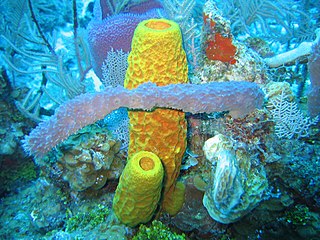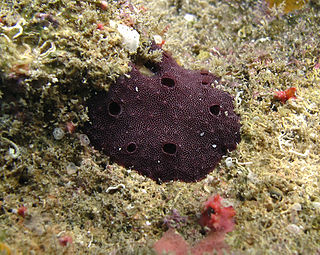| Dendroceratida | |
|---|---|
 | |
| Chelonaplysilla violacea off Réunion | |
| Scientific classification | |
| Kingdom: | |
| Phylum: | |
| Class: | |
| Subclass: | |
| Order: | Dendroceratida Minchin, 1900 |
| Families | |
| |
In taxonomy, the Dendroceratida are an order of sponges of the class Demospongiae. [1] They are typically found in shallow coastal and tidal areas of most coasts around the world. They are generally characterized by concentric layers of fibers containing spongin (a collagen-like material), and by large flagellated chambers that open directly into the exhalant canals. Along with the Dictyoceratida, it is one of the two orders of demosponges that make up the keratose or "horny" sponges, in which a mineral skeleton is minimal or absent and a skeleton of organic spongin-containing fibers is present instead. [2]

In biology, taxonomy is the science of defining and naming groups of biological organisms on the basis of shared characteristics. Organisms are grouped together into taxa and these groups are given a taxonomic rank; groups of a given rank can be aggregated to form a super-group of higher rank, thus creating a taxonomic hierarchy. The principal ranks in modern use are domain, kingdom, phylum, class, order, family, genus, and species. The Swedish botanist Carl Linnaeus is regarded as the founder of the current system of taxonomy, as he developed a system known as Linnaean taxonomy for categorizing organisms and binomial nomenclature for naming organisms.
Spongin, a modified type of collagen protein, forms the fibrous skeleton of most organisms among the phylum Porifera, the sponges. It is secreted by sponge cells known as spongocytes.
Collagen is the main structural protein in the extracellular space in the various connective tissues in the body. As the main component of connective tissue, it is the most abundant protein in mammals, making 25% to 35% of the whole-body protein content. Collagen consists of amino acids wound together to form triple-helices of elongated fibrils. It is mostly found in fibrous tissues such as tendons, ligaments, and skin.








